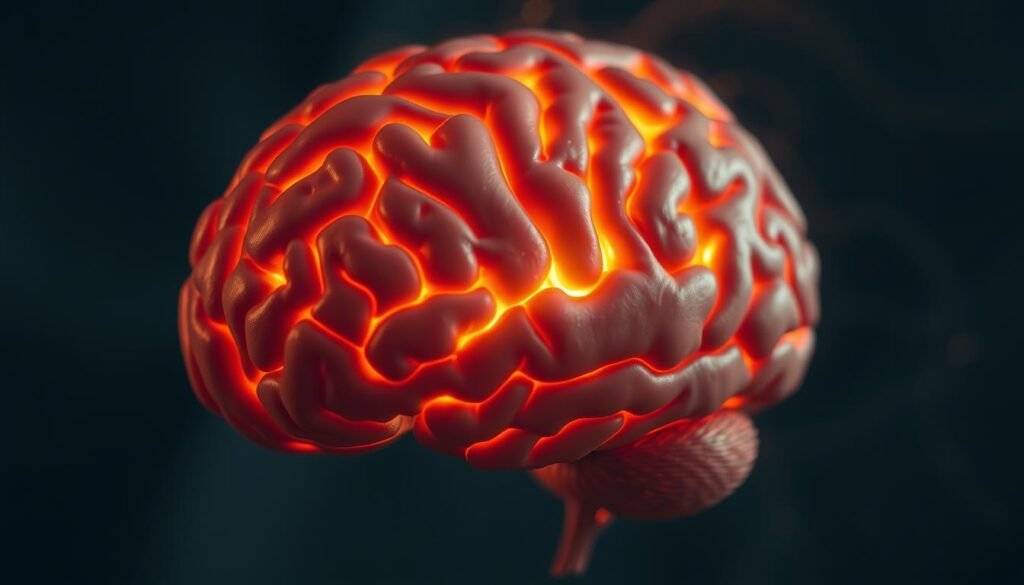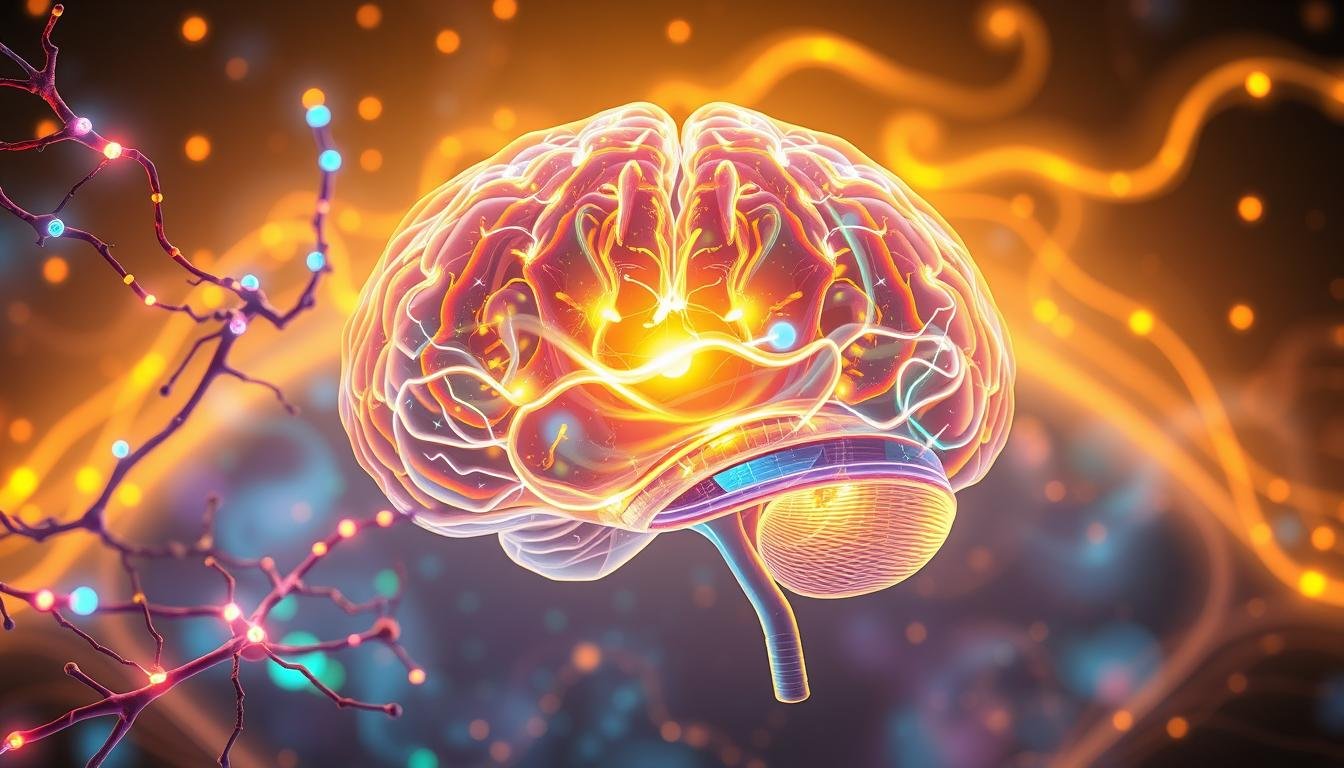Table of Contents
Have you ever wondered why some people seem to effortlessly come up with brilliant ideas while others struggle? The answer lies in the brain and its complex systems. Contrary to popular belief, creativity isn’t just a right-brain activity. It’s a dynamic process involving multiple neural networks working together.
Psychologist John R. Hayes defined creativity as “the potential to produce creative works.” Modern research shows that it’s a brain-wide process. It integrates memory, stimuli, and problem-solving. This thinking process is like a cognitive symphony, where different networks—salience, default mode, and executive attention—play their parts.
Understanding this process can help us unlock our own creative potential. Whether it’s daydreaming or solving complex problems, the mind is constantly at work. Let’s dive deeper into how these systems interact and what this means for our everyday lives.
Key Takeaways
- Creativity involves multiple neural networks, not just the right brain.
- Memory, stimuli, and problem-solving are key components of creative thinking.
- The salience, default mode, and executive attention networks play crucial roles.
- Daydreaming and stress responses are linked to creative processes.
- Understanding these systems can help enhance personal creativity.
Introduction: Unlocking the Mysteries of Creativity
What makes some individuals naturally excel at generating unique ideas? At its core, creativity is the ability to solve problems in ways that are both novel and useful. It’s not just about artistic expression; it’s a cognitive process that involves balancing originality with practicality.
Roger Beaty’s research sheds light on this phenomenon. Using fMRI studies, he discovered that highly creative people exhibit unique patterns of brain connectivity. Three key networks—salience, default mode, and executive attention—work together to fuel innovative thinking.

Creativity isn’t limited to geniuses or professionals. Psychologists distinguish between “Big-C” creativity, seen in groundbreaking works, and “little-c” creativity, which is part of everyday life. Both rely on the same brain mechanisms but differ in scale and impact.
Tests like divergent thinking, where individuals list uncommon uses for objects, highlight the role of cognitive flexibility. Memory and cognitive control also play crucial roles, enabling people to draw on past experiences while exploring new possibilities.
Examples abound, from jazz musicians improvising melodies to scientists formulating hypotheses. These activities showcase how the brain combines knowledge and imagination to produce groundbreaking ideas. Understanding this process can help anyone tap into their creative potential.
How the Brain Sparks Creativity
The brain’s ability to generate innovative ideas is a fascinating process involving multiple networks. These systems work together to turn simple thoughts into groundbreaking concepts. Understanding how they interact can help us unlock our full creative potential.

The Role of the Salience Network
The salience network, located in the anterior insula and dorsal anterior cingulate cortex, plays a crucial role in creativity. It helps prioritize stimuli, such as identifying what’s important in a given situation. For example, during a fight-or-flight response, this network ensures quick decision-making.
Stanford’s Greicius linked this network to motivation and action readiness. Studies show that blocking it in lab animals reduces perseverance. This highlights its importance in maintaining focus and drive during creative tasks.
The Default Mode Network and Daydreaming
The default mode network activates during rest, enabling activities like daydreaming and memory recall. It’s responsible for those “aha!” moments when ideas suddenly click. For instance, Einstein’s insights into relativity reportedly came during moments of mind-wandering.
This network also involves the hippocampus, which helps simulate future scenarios. Disruptions in this system are linked to conditions like Alzheimer’s, showing its critical role in cognitive processes.
The Executive Attention Network and Focus
The executive attention network, located in the lateral prefrontal and parietal regions, manages working memory and focus. It filters distractions, allowing us to concentrate on complex tasks. This system is essential for turning raw ideas into actionable solutions.
Research by Beaty, published in PNAS, shows that highly creative individuals exhibit unique co-activation of these networks. This synergy between focus, imagination, and memory is what drives innovative thinking.
The Science Behind Creativity: Key Findings
How do our neural networks collaborate to spark innovation? A 2018 study by Roger Beaty, published in PNAS, provides fascinating insights. Using fMRI scans, Beaty discovered that stronger connectivity between the default, executive, and salience networks predicts higher creativity scores. This finding highlights the brain’s ability to integrate spontaneous ideas with critical evaluation.
One standout example from the study involved participants imagining uncommon uses for a brick. High-creativity individuals proposed ideas like using it as a water filter. This task showcased how functional connectivity maps correlate with originality. The interplay between the default mode network (for spontaneous ideas) and the executive network (for critical thinking) is key to innovative thinking.

Beaty’s research also used machine learning models to predict creative performance. These models accurately identified individuals with high creativity based on their brain activity. This approach mirrors advancements in AI, such as generative adversarial networks (GANs), which simulate creative processes in machines.
Understanding these neural interactions can help us harness our own creative potential. By fostering connections between different brain regions, we can enhance our ability to generate groundbreaking ideas. Whether in art, science, or everyday problem-solving, the brain’s dynamic processes are at the heart of innovation.
Memory and Creativity: The Brain’s Knowledge Bank
How does our ability to remember shape the way we create? The hippocampus, a key brain region, plays a central role in this process. It helps us construct simulations of past and future events, blending memory with imagination to fuel innovative ideas.
Studies show that episodic specificity induction—recalling vivid details from past experiences—can boost divergent thinking by 20-30%. fMRI scans reveal that this process activates the left anterior hippocampus, highlighting its importance in creative thinking.
For example, in Roger Beaty’s research, participants were asked to list uncommon uses for a cup. Those who recalled specific experiences, like a recent video, generated more original ideas. This demonstrates how detailed memory recall enhances creativity.
Amnesiacs, who struggle with memory recall, often find it difficult to imagine future scenarios. This underscores the hippocampus’s role in recombining episodic details to form new ideas. Without this ability, the creative process is significantly hindered.
Conditions like Alzheimer’s, which degrade the default network, also reduce creativity. This further emphasizes the link between healthy brain regions and the ability to innovate. By understanding these connections, we can better harness our creative potential.
Divergent Thinking: The Gateway to Innovation
What sparks the ability to think outside the box and generate groundbreaking ideas? The answer lies in a cognitive process called divergent thinking. Unlike convergent thinking, which focuses on finding a single correct answer, divergent thinking explores multiple solutions to a problem.

Tests measuring divergent thinking often ask participants to list uncommon uses for everyday objects. For example, using a sock as a water filter showcases originality. These tasks highlight the brain’s capacity to connect unrelated concepts and generate innovative solutions.
Roger Beaty’s research used word-pair tests, such as connecting “rowboat” and “parrot,” to study creativity. These tests reveal how people navigate between familiar and novel ideas. The results correlate with human creativity ratings, demonstrating the importance of flexible thinking.
However, mental blocks, or fixation, can hinder divergent thinking. Episodic induction, which involves recalling vivid memories, helps break these barriers. By simulating past experiences, the brain can recombine details to form new ideas.
IBM’s “co-creative agents” illustrate how AI can assist in innovation. These systems mimic human divergent thinking, suggesting unconventional solutions to complex tasks. This technology underscores the potential of combining human and machine creativity.
One famous example of divergent thinking is the invention of Post-it Notes. What began as a failed adhesive became a revolutionary product. This accidental breakthrough highlights the power of exploring unexpected possibilities.
By understanding and practicing divergent thinking, anyone can enhance their creative ability. Whether solving everyday problems or tackling complex challenges, this process unlocks the potential for groundbreaking innovation.
Can Creativity Be Enhanced? What Science Says
Is it possible to train your brain to become more creative? Research suggests that creativity isn’t just an innate ability—it can be developed through specific training and practices. A neuroscience-backed approach reveals how we can unlock greater creative potential.
One key debate centers on whether creativity is a trait or a state. Trait creativity refers to long-term, stable skills, while state creativity involves short-term boosts. Studies show that even brief interventions, like taking breaks, can engage the default mode network, leading to innovative ideas.
Music training, for example, has been linked to domain-specific creativity gains. Learning an instrument enhances cognitive flexibility, a critical component of creative thinking. However, not all training methods are equally effective. Brain-training apps like Lumosity have faced skepticism due to their limited transfer effects.
Arts education, on the other hand, offers a promising strategy. Engaging in creative tasks, such as painting or writing, fosters neural connections that support innovation. By understanding and applying these findings, people can take control of their creative development.
Conclusion: Harnessing the Power of Your Creative Brain
Unlocking your creative potential starts with understanding how your brain works. The interplay between the default, executive, and salience networks is key to generating innovative ideas. These systems allow you to balance imagination with focus, turning raw thoughts into actionable solutions.
Embrace both mind-wandering and focused work phases. Daydreaming activates the default mode network, sparking “aha!” moments. Meanwhile, the executive network helps refine those ideas into practical outcomes. This dynamic process is what drives creativity.
Practical tips can enhance your creative thinking. Try detail-oriented memory exercises or engage in creative hobbies like painting or writing. These activities strengthen neural connections, fostering innovation in everyday scenarios, from workplace challenges to personal projects.
As Roger Beaty puts it, “Creativity isn’t magic—it’s cognitive engineering.” By understanding and applying these principles, anyone can tap into their creative potential and transform the way they work and think.
FAQ
What role does the salience network play in creativity?
The salience network helps the brain identify important information, filtering out distractions. It plays a key role in switching between different thinking modes, which is essential for generating new ideas.
How does the default mode network contribute to creativity?
The default mode network activates during rest or daydreaming. It allows the mind to wander, connect unrelated concepts, and foster imaginative thinking, which is crucial for creative problem-solving.
What is the executive attention network’s role in creative thinking?
The executive attention network helps focus and control thoughts. It allows individuals to evaluate ideas, refine them, and stay on task during the creative process.
How does memory influence creativity?
Memory acts as the brain’s knowledge bank, storing experiences and information. Creative individuals often draw from this reservoir to combine old ideas in new ways, leading to innovative solutions.
What is divergent thinking, and why is it important?
Divergent thinking is the ability to generate multiple solutions to a problem. It’s a cornerstone of creativity, enabling people to explore various possibilities and think outside the box.
Can creativity be enhanced through practice?
Yes, studies show that creativity can be improved with practice. Techniques like brainstorming, mindfulness, and exposure to diverse experiences can strengthen creative skills over time.
What brain regions are most active during creative tasks?
The prefrontal cortex, hippocampus, and default mode network are often active during creative tasks. These regions work together to process information, retrieve memories, and generate new ideas.
How does music or art impact creative thinking?
Music and art stimulate the brain’s imagination and emotional centers. Engaging with these activities can enhance divergent thinking and inspire innovative ideas.
What role does psychology play in understanding creativity?
Psychology helps explain how thoughts, emotions, and experiences shape creative processes. It provides insights into how individuals develop and express their creative abilities.
Can stress affect creativity?
While mild stress can sometimes boost focus, chronic stress often hinders creativity. It limits the brain’s ability to relax, daydream, and explore new ideas freely.


